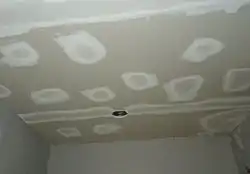Spackling paste
In the United States, spackling paste is a putty used to fill holes, small cracks, and other minor surface defects in wood, drywall, and plaster.[1][2] Typically, spackling is composed of gypsum plaster from hydrated calcium sulfate and glue.

Trademark
Spackle is a registered trademark of the Muralo Company, located in Bayonne, New Jersey.[3] Muralo's product is dry powder, to be mixed with water by the user to form putty or paste. It was brought to market in 1927, then patented and trademarked in 1928. The term "spackle" has since become a genericized trademark applied in the United States to a variety of household hole-filling products. (Such products may also be referred to as "spackling" compounds.)
The first written appearance of the generic use of the word "spackle" was around 1940.[4] The product name was likely derived from the German word spachtel, meaning "putty knife" or "filler." Other possible origins include Russian шпаклевать (tr. shpaklevat; to fill holes with putty or caulk), Polish szpachla (spatula or putty knife), and Yiddish spaklieven (to fill in small holes in plaster), all of which are likely derived from German.
Polyfilla
In the UK, Ireland, South Africa, Australia, and Canada, the brand "Polyfilla", multi-purpose filler, is used as a generic term for spackling paste,[5][6] even though it differs from spackle in being cellulose based. The manufacturers claim that it has an advantage over spackle in that it doesn't shrink or crack.[7][8]
See also
References
- "How to Stencil With Spackling Paste". sfgate.com. Retrieved 19 June 2017.
- "What is the difference between spackle and plaster?". Reference.com. Retrieved 19 June 2017.
- "SYNKOLOID'S - Trademark Details". trademarks.justia.com. Retrieved 19 June 2017.
- "spackle". Merriam-Webster Online. Retrieved 2015-11-21.
- Hitchcock, Karen (2013). Little white slips. [Sydney]: Picador Australia. p. 19. ISBN 9781742620299. Retrieved 24 January 2017.
A nice Polyfilla kind of lady
- Committee, Treasury (2008). Counting the population : written evidence. London: TSO. p. 184. ISBN 9780215038036.
sources patched up with statistical Polyfilla
- Poly Website Australia
- Polycell UK